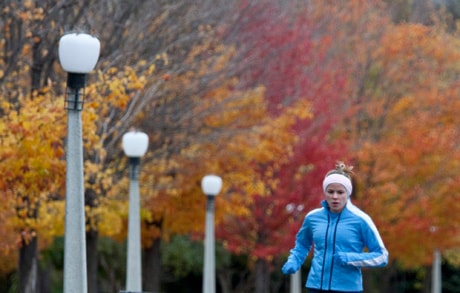TORONTO — Canada’s physical activity guidelines are getting a makeover, reflecting a “more is better” approach that emphasizes the need for both vigorous and strengthening activities in the lives of youngsters, adults and seniors.
The revised guidelines released Monday by the Canadian Society for Exercise Physiology recommend children and youth aged five to 17 get at least 60 minutes of moderate to vigorous intensity physical activity daily. This should include both vigorous-intensity activities and muscle and bone-strengthening activities at least three days a week.
Adults aged 18 to 64 and older adults 65 and up are recommended to get at least 150 minutes of moderate to vigorous-intensity aerobic physical activity per week, in bouts of 10 minutes or more.
The guidelines state it’s also beneficial for both younger and older adults to add muscle and bone strengthening activities using major muscle groups at least two days a week. Older adults with poor mobility are advised to do physical activities to enhance balance and prevent falls.
Moderate physical activities include brisk walking, skating and bike riding. Playing hockey, basketball, soccer, running and swimming are examples of vigorous activities.
Hopscotch, skipping, jumping rope, climbing, tug of war, push-ups, sit-ups and weight training are among examples of muscle and bone-strengthening activities.
Being active isn’t tied solely to sporting activities. General gardening and ballroom dancing are among the examples of moderate-intensity activities for adults. Other suggestions to help adults get moving include raking the lawn or walking to work. For older adults, taking the dog out for a walk or a weekend nature hike are among the possible activities.
Previous guidelines recommended children and youth work towards getting at least 90 minutes of physical activity a day. The daily target for adults was at least 60 minutes daily, while older adults were recommended to accumulate 30 to 60 minutes of moderate physical activity on most days.
Physical activity guidelines for adults were first released in 1998, followed by guidelines for older adults in 1999, and children and youth in 2002.
The new guidelines are based on four years of research analysis. Partner organizations including CSEP, ParticipAction, the Public Health Agency of Canada and Active Healthy Kids Canada are working to disseminate and implement the new guidelines. The society’s website (www.csep.ca) will include information sheets for all groups outlining the guidelines, health benefits of achieving them, and ways individuals can meet the guidelines.
Draft guidelines were sent out last September and October for online consultation, with more than 1,000 national and international content experts, health professionals, governmental and non-governmental organizations, teachers, and caregivers offering responses. The majority of respondents “completely agreed” with the proposed preamble and guidelines.
Mark Tremblay, CSEP’s chair of the physical activity guidelines committee, said the process began with a think-tank in 2006 to determine if the existing recommendations were still accurate based on the best available evidence.
“There’s enough evidence in the literature now to say... to derive significant health benefits, you need moderate to vigorous physical activity daily,” he said in a phone interview from Ottawa. “We didn’t have evidence for that in around 2000 when evidence was being assessed for the existing guidelines, so we’re confident putting that line in the sand now.”
“We’re also confident in saying more is better, and that applies from across the board and that’s a consistent theme that is certainly substantiated by the literature, the early literature and emerging literature.”
The World Health Organization has used information collated by Canadian researchers to create their own guidelines, Tremblay said.
Because the evidence base wasn’t as systematic or scientific in its approach last time, the guidelines avoided designating a specific number for how many minutes of physical activity were needed, noted Tremblay, who is also director of Healthy Active Living and Obesity Research at the Children’s Hospital of Eastern Ontario.
“Instead — and this is partially driven by the evidence at the time — they said if you’re not doing very much now you should do more, if you’re doing a little bit, you should still do more,” he said. “For example, try and get kids to go from those who are doing zero to do 30 minutes and then try and get them another 30 minutes and try and get them another 30 minutes.”
“It was sort of a continuum of going from zero up to 90. That’s where you wanted to try and get to. But meeting the guidelines could be any segment of that.”
Kelly Murumets, president and CEO of ParticipAction, said she thinks the new guidelines will help make things clearer, and that there will be a higher probability of uptake this time around.
The release of the revamped guidelines coincides with the launch of ParticipAction’s “Think Again” campaign, aimed at parents to help them understand their responsibility to protect the health of their children.
Murumets said a recent Statistics Canada report which revealed only 15 per cent of adults and seven per cent of children and youth were meeting basic physical activity targets was “unbelievably alarming.”
She said there is an “inactivity crisis” and hopes that Canadians heed this wake-up call.
“Canadians need to understand physical activity isn’t a nice-to-do — it is imperative,” said Murumets.
“There are 25 chronic diseases directly linked to physical inactivity. We know kids today are experiencing symptoms or exhibiting symptoms of chronic diseases that they should never be experiencing at this young age, and it is ... in some cases, because of physical inactivity,” she said.
“Our kids, in fact, might have a shorter life expectancy than we do, the first time that trend has ever been reversed,” she added. “We must have parents hear this message. They must understand this is an urgent matter.”
